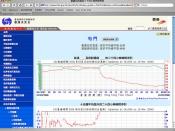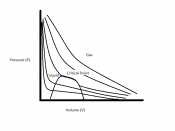In this experiment, you will generate data to develop hypotheses that relate pressure and volume, and pressure and temperature. In the first case, you will compress and expand a sample of air and measure how its pressure changes. In the second, you will cool and heat a sample of air to see how its pressure changes.
1. Write a purpose.
The purpose of this lab is to monitor the pressure changes in two different scenarios (compressing and expanding a sample of air, and cooling and heating a sample of air). This data will be used to help us understand the relationships between pressure and volume, and pressure and temperature.
2. When varying pressure and volume (as in BoyleÃÂs Law) to understand how they are related, what other variables of the gas must remain constant?When varying pressure and volume to understand how they are related, the number of moles and the temperature of the gas must remain constant.
BoyleÃÂs LawP1V1 = P2V23. When varying pressure and temperature (as in Gay-LussacÃÂs Law) to understand how they are related, what other variables of the gas must remain constant?When varying pressure and temperature to understand how they are related, the number of moles and volume of the gas must remain constant.
Gay-LussacÃÂs Law --> P and T (variables); V and N (constants)P1 = P2T1 T2As you increase the pressure, causes the temperature to increase.
-direct relationship between pressure and temperature (diagonal line graph)since temperature is the measure of the average amount of kinetic energy â if temperature increases the faster the particles are moving and there is an increased number of collisions with the walls of the container (which is increased pressure)-pressure cooker --> speeds up cooking time because the high pressures cause the food to be cooked at much higher temperaturesUse BoyleÃÂs, CharlesÃÂ, or Gay-LussacÃÂs law to calculate the missing value in each of the following.
a. V1 = 2.0 L, P1 = 0.82 atm, V2 = 1.0 L, P2 = ?P2 = P1V1 = (0.82 atm)(2.0 L) = 1.6 atmV2 1.0 Lb. Vì1 = 250 mL, T1 = ?, V2 = 400 mL, Tì2 = 298 KT1 = T2V1 = (298 K)(250 mL) = 186 K â 200 KV2 400 mLc. V1 = 0.55 L, P1 = 740 mm Hg, V2 = 0.80 L, P2 = ?P2 = P1V1 = (740 mm Hg)(0.55 L) = 510 mm HgV2 0.80 Ld. T1 = 25ðC, P1 = ?, T2 = 37ðC, P2 = 1.0 atmT1 = 25ðC + 273 = 298 KT2 = 37ðC + 273 = 310 KP1 = P2T1 = (1.0 atm)(298 K) = 0.96 atmT2 (310 K)





